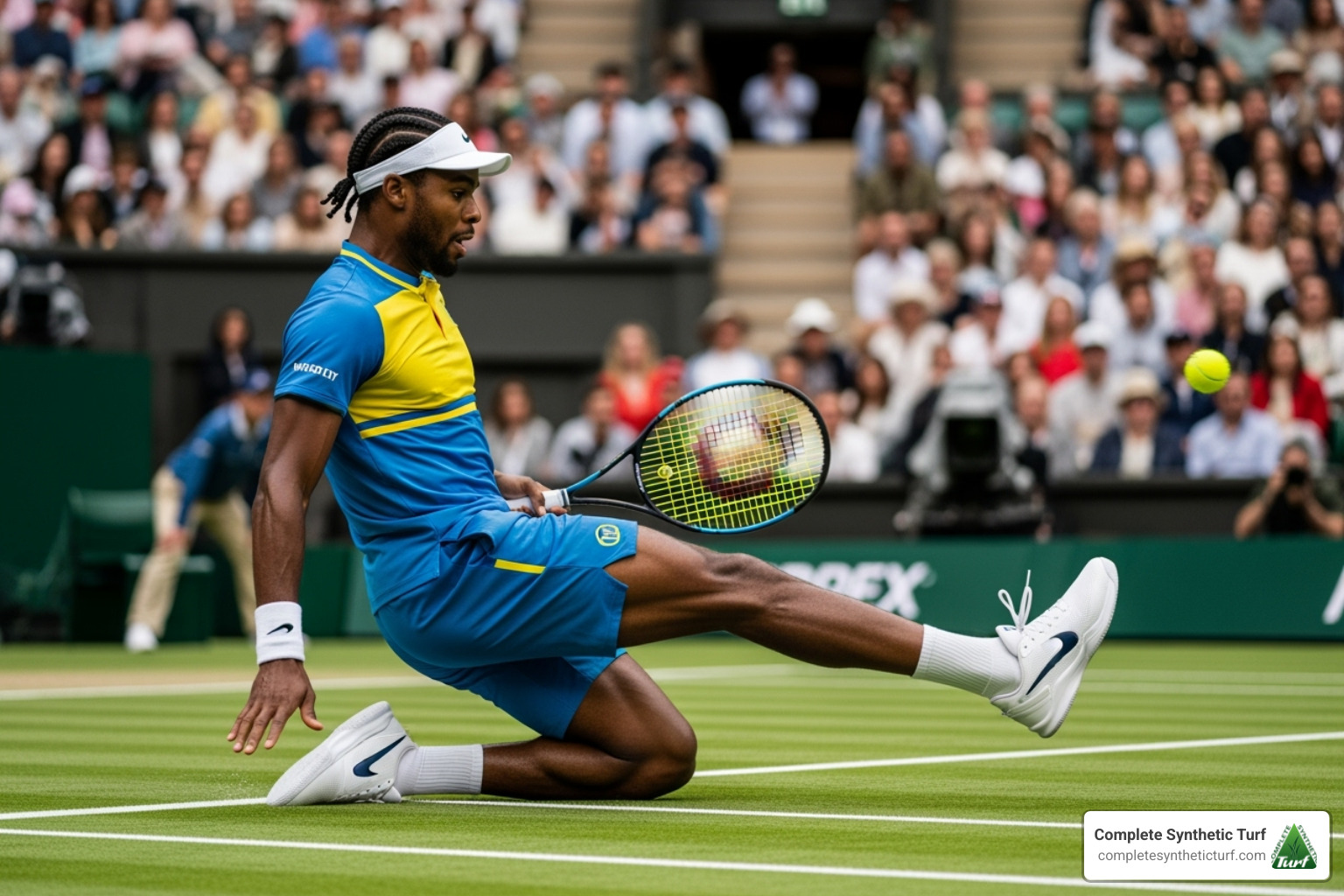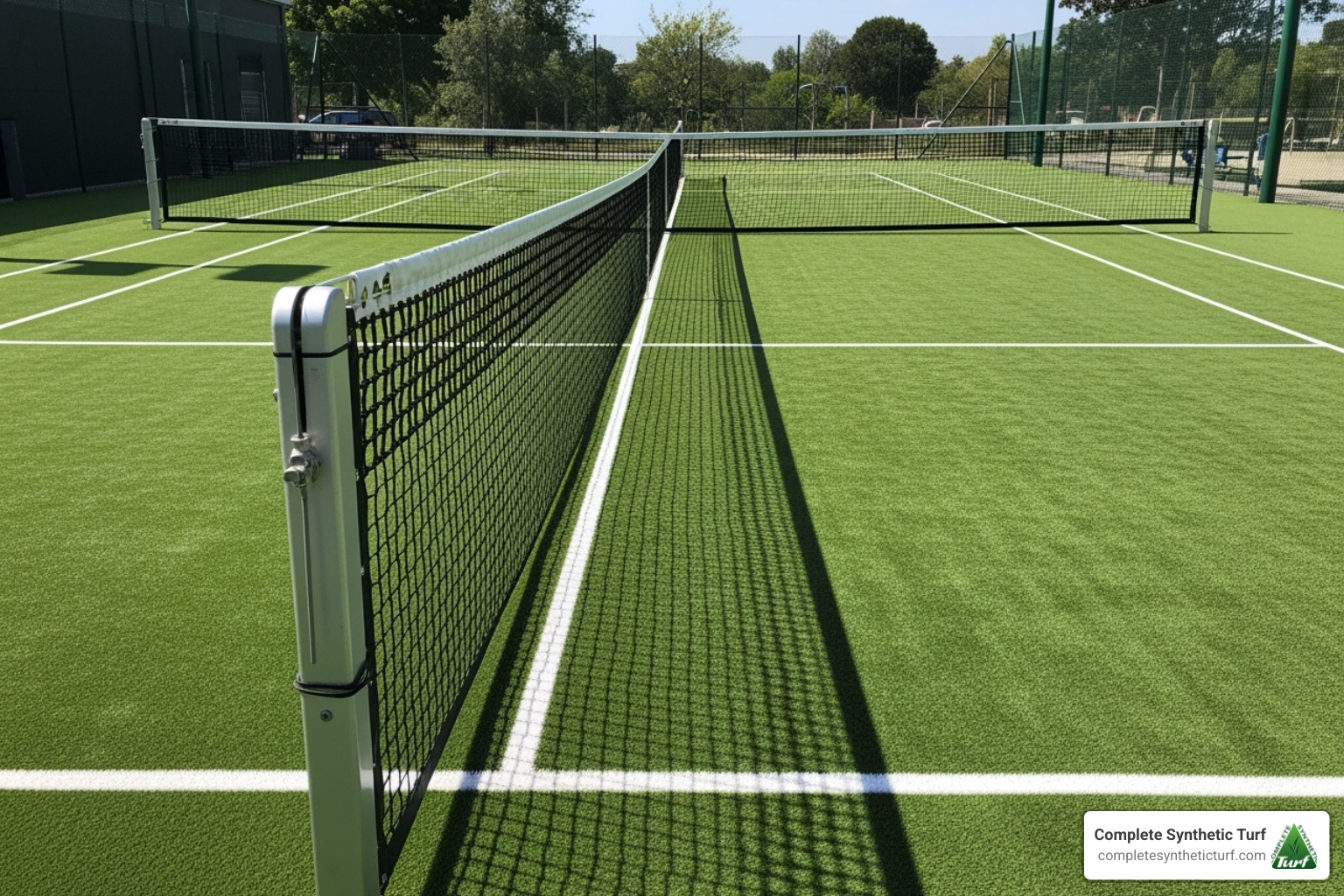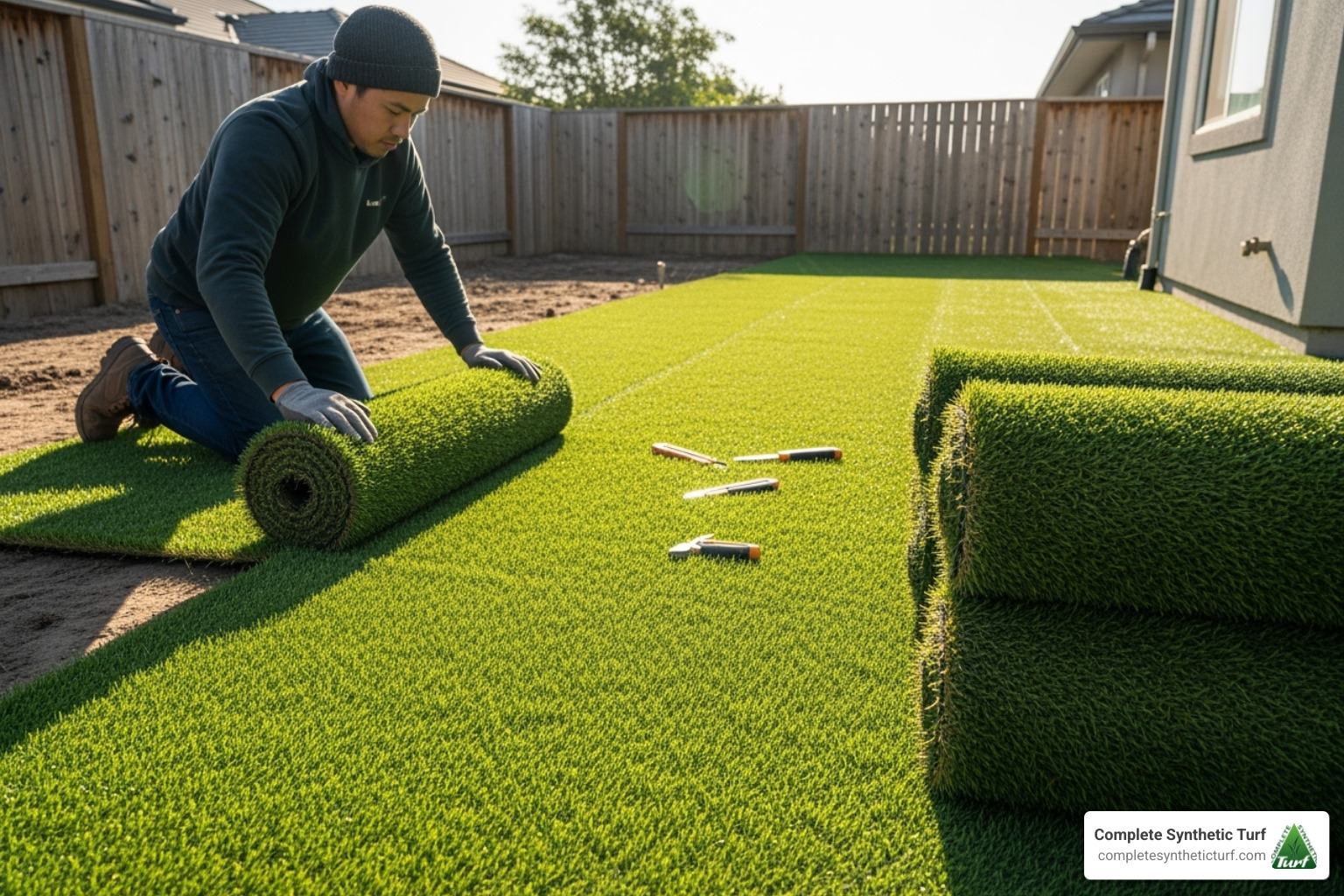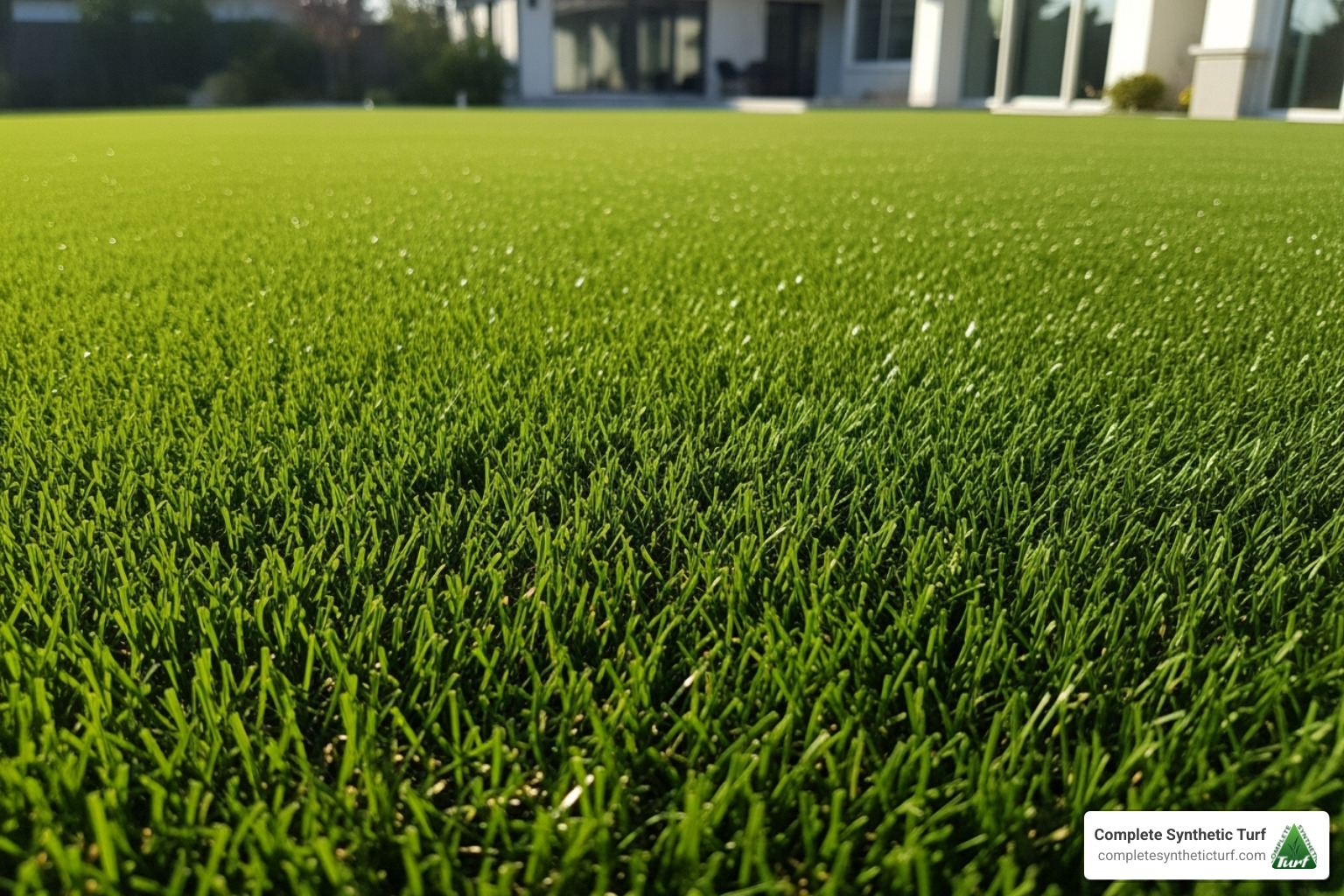Fake grass tennis court: 5 Unbeatable Benefits
Why Fake Grass Tennis Courts Are Revolutionizing the Game
The Modern Advantage: Key Benefits of a Fake Grass Tennis Court
Picture this: it’s 2 PM on a Tuesday in Stuart, Florida, and it just finished pouring rain. While the hard courts across town are still puddles of standing water, you’re already back on your fake grass tennis court, racket in hand, ready to play.
This isn’t just wishful thinking – it’s the reality that thousands of tennis players are finding. The benefits of artificial grass tennis courts go way beyond simple convenience. These modern surfaces are quietly revolutionizing how we think about tennis court ownership, one game at a time.
When you look at the numbers, the story becomes crystal clear. Traditional hard courts crack and need complete resurfacing every 5–7 years. Natural grass courts? They’re beautiful but demand daily attention – watering, mowing, fertilizing, and constant worry about weather damage. Meanwhile, artificial grass courts just keep performing, year after year, with barely any fuss. As the International Tennis Federation explains, surface selection plays a huge role in both performance and long-term maintenance requirements.
The Why Synthetic Grass? question becomes a no-brainer when you realize that synthetic courts eliminate all those unpredictable headaches. No more cancelled matches because of morning dew. No more uneven bounces from worn spots. No more scheduling your life around the lawn guy.
Here’s what makes artificial grass courts such game-changers for both tennis facilities and homeowners: consistent playing surfaces that never develop dead spots, weather independence that lets you play when others can’t, dramatically reduced operating costs with no water bills or equipment expenses, increased court utilization with more playing hours per day, improved property value that impresses everyone who sees it, serious environmental benefits through water conservation, improved player safety with cushioned surfaces, and year-round aesthetic appeal that stays gorgeous in every season.
Best Durability and Longevity
Here’s where artificial grass tennis courts really shine – they’re built to last. While traditional hard courts crack and split every time the temperature changes or the ground shifts slightly, synthetic surfaces just roll with the punches.
Modern artificial turf systems use UV-stabilized fibers that laugh at Florida’s intense sun. This isn’t just marketing talk – the UV protection technology actually keeps colors vibrant and fibers strong throughout the court’s entire lifespan. No more faded, brittle surfaces that look tired after just a few years.
The lifespan numbers are impressive: properly installed artificial grass tennis courts can last 10–25 years before needing replacement. That’s not just good – that’s exceptional value for your investment.
What makes them so durable? It starts with superior materials – high-grade polyethylene and polypropylene fibers that resist wear like champions. Then there’s professional installation with proper base preparation and drainage that prevents problems before they start. The even weight distribution means no concentrated wear spots, and the weather resistance handles everything from scorching heat to torrential downpours.
The A New Era for Sports Turf has definitely arrived. These artificial surfaces now match or beat traditional courts in performance while making maintenance a breeze.
Even heavy foot traffic, which would quickly destroy natural grass, barely affects quality artificial turf. The synthetic fibers are designed to spring back after compression, maintaining their upright position and playing characteristics even after the most intensive tournaments.
Maximum Playtime, Minimum Maintenance
This is where artificial grass courts really win hearts and minds. Traditional courts sit empty way too often – because of weather, maintenance schedules, or repairs. Artificial grass courts? They’re ready when you are.
The all-weather performance is remarkable. These courts feature drainage systems that handle water like magic. The perforated backing and properly designed sub-base work together so efficiently that courts can be playable within minutes after even heavy rain. Compare that to hours or days for other surfaces.
Living in Florida, we know about intense thunderstorms. Properly installed artificial grass systems handle them without breaking a sweat. No standing water, no unsafe conditions, just consistent scheduling for tournaments, lessons, and weekend games with friends.
The maintenance requirements are almost laughably simple. Research shows synthetic courts need about 30 minutes of maintenance per week. That’s it. Compare that to several hours for natural grass courts, and you’ll understand why facility managers are making the switch.
What does that 30 minutes include? Light brushing to keep fibers looking their best, occasional debris removal, periodic infill top-ups, and annual deep cleaning. The Artificial Turf Maintenance for Sports Turf process is straightforward and doesn’t require specialized equipment or a crew of groundskeepers.
The cost savings add up fast. Facility managers report eliminating expenses for daily watering systems, weekly mowing and edging, fertilizer and pesticide applications, seasonal reseeding, specialized groundskeeping equipment, and full-time maintenance staff. That’s real money back in your pocket.
Superior Player Comfort and Safety
Player comfort isn’t just nice to have – it’s essential for enjoying the game and staying injury-free. Fake grass tennis courts provide cushioned surfaces with shock absorption that reduces stress on knees and ankles, the joints that take the biggest beating in tennis.
Traditional hard courts can cause “foot lock” – that jarring sudden stop that places tremendous stress on joints and ligaments. Artificial grass courts allow for slight foot sliding when stopping and pivoting, similar to natural grass or clay courts. This natural movement pattern reduces injury risk and makes playing more comfortable.
The shock absorption properties are scientifically proven. Quality artificial turf can reduce impact forces by up to 40 % compared to hard courts. That means longer playing sessions with less soreness afterward, and reduced risk of overuse injuries that can sideline players for weeks.
Surface consistency is another huge safety advantage. Unlike natural grass that develops holes, divots, or uneven areas, artificial turf maintains a perfectly consistent surface that reduces the risk of trips and falls. Players can focus on their strategy instead of worrying about unpredictable surface conditions.
This reliability is particularly valuable for competitive players and tennis academies where skill development is paramount. When the surface behaves predictably, players can develop consistent techniques and build confidence in their game.
From the Ground Up: Construction and Installation

Building a fake grass tennis court is like creating a high-performance sandwich – each layer serves a specific purpose, and getting them right makes all the difference in how your court performs for decades to come.
After 60 years in the business, we’ve learned that the secret to a great artificial grass tennis court isn’t just in the turf itself. It’s in what happens underneath that turf that really matters. Think of it this way: you wouldn’t build a house on a shaky foundation, and you shouldn’t install artificial grass on anything less than perfect preparation.
The construction process might seem complex at first glance, but it follows a logical sequence that ensures your court will drain properly, play consistently, and look beautiful for years. Our Artificial Grass Installation process has been refined through thousands of successful projects across Florida’s challenging climate.
Understanding the Construction of a Fake Grass Tennis Court
The magic starts with foundation preparation. We excavate the court area to exactly the right depth – typically 6 to 8 inches below where your finished surface will be. This isn’t just digging a hole; it’s creating a precisely graded foundation that ensures water flows exactly where it should go.
Next comes the crushed stone base, which is honestly the unsung hero of artificial grass courts. This layer needs to be compacted to 95% compaction – a technical way of saying it’s packed down so tight that it won’t shift or settle over time. Getting this right prevents those annoying dips and bumps that can develop in poorly constructed courts.
The geotextile weed barrier goes on next, and it’s your court’s insurance policy against unwanted vegetation. This fabric lets water drain through while keeping weeds from pushing up through your playing surface. Trust us – you don’t want to deal with weeds poking through your court lines during an important match.
Rolling out the turf is where things get exciting. The synthetic grass carpet must be positioned with precision, and the seaming process requires real skill. When done properly, you won’t be able to see where pieces join together – the surface looks and plays like one continuous field.
Finally, sand infill application completes the system. This isn’t just dumping sand on top – the sand gets brushed deep into the base of the grass fibers where it provides stability, improves drainage, and helps the fibers stand upright for consistent ball bounce.
Resurfacing an Existing Court
Converting hard courts to artificial grass is often the smartest move for tennis facility owners. Instead of dealing with another cycle of cracks and repairs, you can upgrade to a surface that won’t give you those headaches.
The process starts with sealing cracks and leveling the base of your existing court. Most concrete or asphalt courts provide an excellent foundation for artificial grass, which means you’re not starting from scratch. This approach represents a cost-effective upgrade that often costs less than traditional resurfacing while providing superior long-term value.
Our Tennis Court Resurfacing with Artificial Grass service has transformed courts throughout Florida, turning maintenance headaches into low-maintenance assets. The conversion typically takes just 3 to 5 days, depending on your court’s condition and any necessary repairs.
The best part? Once we’re done, you’ll have a court that plays better than new while requiring almost no maintenance. No more scheduling around crack repairs or dealing with surfaces that become unplayable after heavy rain.
How Artificial Turf Transforms the Game
The moment you step onto a fake grass tennis court, you’ll notice something special. The surface feels different under your feet – more forgiving than concrete, more consistent than natural grass. It’s this unique combination that’s changing how tennis is played around the world.
After six decades in the business, we’ve seen how artificial turf changes the game. Our Sports Turf Installation process creates surfaces that don’t just look great – they fundamentally improve how tennis feels and plays.
The beauty of artificial grass courts lies in their predictability. While natural grass can surprise you with a bad bounce or a soft spot, synthetic surfaces deliver the same reliable performance whether it’s your first game of the day or your third set in the Florida heat.
Ball Bounce, Speed, and Consistency
When you hit a ball on a properly installed artificial grass court, it responds exactly as you’d expect. The medium-paced play sits perfectly between the lightning-fast speed of natural grass and the slower, grinding pace of clay courts.
Consistent ball bounce is perhaps the most noticeable difference. On natural grass, you might get a perfect bounce on one side of the court and a dead spot on the other. With artificial turf, every bounce is predictable. The ball rises to the same height whether you’re playing at the net or from the baseline.
This consistency comes from the engineered surface and carefully distributed sand infill. The uniform construction means true shot response across the entire court. Your topspin shots will grip the surface just right, while your slice shots maintain their intended path. You can finally trust your shots to behave the way you planned them.
Unlike natural surfaces that get affected by leaves, dirt, or morning dew, artificial grass courts resist these variables. A quick sweep removes any debris, and you’re back to perfect playing conditions. This debris resistance means more consistent play throughout the year.
When compared to other surfaces, artificial grass offers the best of all worlds. You get more consistent bounce than natural grass, with none of the dead spots or weather-related variations. The surface is softer on joints than hard courts, reducing that jarring impact on your knees and ankles. And unlike clay courts, there’s no mess, no line disputes from ball marks, and no hours of daily maintenance.
Player Movement and Injury Prevention
The way you move on artificial grass feels natural and safe. The cushioned surface absorbs impact in a way that hard courts simply can’t match. Your knees and ankles will thank you after long practice sessions or tournament play.
Studies show that artificial turf surfaces can reduce impact forces by up to 40% compared to hard courts. This isn’t just a number – it’s the difference between walking off the court feeling energized versus feeling beaten up. The multi-layer construction creates a surface that gives just enough to protect your joints while maintaining the stability you need for quick movements.
Proper traction is crucial, and artificial grass courts deliver it perfectly. The sand-filled surface provides excellent grip for quick starts and explosive movements, while still allowing for that controlled sliding that’s so characteristic of grass and clay courts. This balance prevents the jarring stops that can lead to ankle and knee injuries on hard courts.
The surface prevents foot lock – that sudden, joint-jarring stop that happens on hard courts when your shoe grips too aggressively. Instead, artificial grass allows for natural movement patterns that feel comfortable and reduce injury risk.
For footwear, tennis shoes designed for artificial turf or multi-surface play work best. These shoes provide the right balance of traction and controlled sliding that makes artificial grass courts so comfortable to play on. The slight sliding capability requires shoes that allow for natural movement while keeping you in control of your game.
Whether you’re a weekend warrior or a competitive player, the reduced stress on joints means you can play longer, train harder, and recover faster. That’s the kind of advantage that keeps you coming back to the court day after day.
The Financials: Cost vs. Value Over Time

Understanding the financial aspects of artificial grass tennis courts requires looking beyond the initial investment to consider long-term value, maintenance savings, and property improvement.
The economics of fake grass tennis courts become compelling when you analyze total cost of ownership over the surface’s lifespan. While the upfront investment may be higher than some alternatives, the long-term savings and benefits often justify the initial expense.
Our Turf Installation Cost analysis helps clients understand the complete financial picture, including both immediate and long-term considerations.
Initial Installation and Resurfacing Costs
The cost of installing an artificial grass tennis court varies based on several factors, but industry data provides helpful benchmarks for planning purposes.
Cost Range for Standard Courts:
For a standard doubles tennis court, the costs of turf and installation typically range between $30,000 to $60,000. This range reflects variations in:
- Court size and configuration
- Existing base condition
- Drainage requirements
- Turf quality and specifications
- Geographic location and accessibility
- Additional features (lighting, fencing, etc.)
Premium Installation Costs:
High-end installations with premium materials and extensive site preparation can reach up to $100,000 for a complete court system. These installations typically include:
- Complete base reconstruction
- Advanced drainage systems
- Premium turf materials
- Professional line integration
- Comprehensive warranties
Factors Affecting Price:
Several variables influence the final cost of installation:
- Site Preparation: Existing conditions and required excavation
- Drainage Needs: Complexity of water management systems
- Turf Selection: Quality and specifications of synthetic grass
- Infill Type: Sand, rubber, or specialized infill materials
- Installation Complexity: Access, logistics, and site challenges
Our team at Artificial Grass Installers provides detailed estimates that account for all these factors, ensuring clients understand the complete investment required.
Long-Term Value: The Cost-Effectiveness of a Fake Grass Tennis Court
The true value of artificial grass tennis courts becomes apparent when comparing long-term costs across different surface types:
Artificial Grass vs. Hard Court vs. Clay Court Cost Comparison:
| Cost Category | Artificial Grass | Hard Court | Clay Court |
|---|---|---|---|
| Initial Installation | $30,000-$60,000 | $25,000-$40,000 | $20,000-$35,000 |
| Annual Maintenance | $500-$1,000 | $2,000-$4,000 | $5,000-$10,000 |
| Resurfacing (Every 5-7 years) | None | $8,000-$15,000 | $3,000-$6,000 |
| Water Costs (Annual) | $0 | $0 | $2,000-$5,000 |
| 20-Year Total Cost | $40,000-$80,000 | $65,000-$120,000 | $80,000-$170,000 |
Specific Long-Term Savings:
- No Water Bills: Artificial grass courts require no irrigation, saving thousands annually in water costs
- No Resurfacing: Unlike hard courts that crack and require periodic resurfacing, artificial grass maintains its integrity for decades
- Minimal Maintenance Labor: Reduced need for professional maintenance services
- No Equipment Costs: Elimination of mowing, watering, and specialized maintenance equipment
- Increased Utilization: More playing hours generate additional revenue for commercial facilities
Property Value Improvement:
Installing a professional-grade artificial grass tennis court can significantly increase property value. Real estate professionals report that well-designed courts can add $50,000-$100,000 to property values, often exceeding the installation cost.
The return on investment becomes even more attractive when considering:
- Improved lifestyle and recreation opportunities
- Reduced ongoing maintenance responsibilities
- Increased property marketability
- Long-term durability and performance

Frequently Asked Questions about Artificial Grass Tennis Courts
Are artificial grass courts suitable for all weather conditions?
Absolutely! Fake grass tennis courts are engineered specifically for year-round play, no matter what Mother Nature throws at them. Their superior drainage systems are truly impressive – water passes through the surface so quickly that you can be back on the court within minutes after even the heaviest Florida thunderstorm.
The UV-stabilized fibers are a game-changer for our intense Florida climate. They won’t fade under our blazing sun or deteriorate from constant UV exposure. Unlike natural grass that can become waterlogged or hard courts that can crack from temperature changes, artificial turf maintains its integrity through every season.
We’ve seen clients playing on their courts just minutes after storms that would shut down other surfaces for hours or even days. That’s the kind of reliability that makes artificial grass courts such a smart investment for Florida homeowners and facilities.
How does playing on fake grass compare to natural grass?
The playing experience on artificial grass is remarkably similar to natural grass, but with far more consistency. Natural grass courts can develop those frustrating dead spots, divots, and unpredictable bounces that can throw off your game. With artificial turf, you get the same reliable playing surface every single time you step on the court.
The ball speed feels just right – medium-paced play that’s slightly slower than natural grass but faster than clay. This sweet spot works beautifully for players of all skill levels. You’ll love how predictable the ball bounce becomes, allowing you to develop consistent techniques without worrying about surprise hops or dead spots.
One of the best features is how artificial grass allows for that controlled sliding that feels so natural. It’s similar to what you’d experience on natural grass or clay courts, but much easier on your joints than the jarring stops required on hard courts. Your knees and ankles will thank you for making the switch!
Where are artificial grass tennis courts most popular?
The numbers tell an amazing story about where artificial grass courts are taking over. In Australia, these courts make up 95% of all tennis facilities – that’s almost complete dominance! Sydney alone has about 9 synthetic grass courts for every single hard court. Western Australia isn’t far behind with synthetic courts making up 45% of all tennis surfaces.
Here in the United States, we’re seeing explosive growth in several key areas. Water-scarce regions are leading the charge, especially where drought conditions make water conservation a priority. High-use facilities like schools, clubs, and public courts love the durability that handles heavy traffic without breaking down.
Tropical climates like ours here in Florida are perfect for artificial grass courts. The combination of intense sun and frequent rain that can wreak havoc on other surfaces is exactly what these courts are designed to handle. We’re installing more residential courts than ever for homeowners who want that luxury amenity without the headache of constant maintenance.
Commercial facilities – hotels, resorts, and country clubs – are choosing artificial grass because it delivers that premium experience their guests expect while dramatically reducing operating costs. It’s becoming clear that artificial grass courts aren’t just a trend – they’re the future of tennis surfaces.
Conclusion
The fake grass tennis court represents a game-changing solution that’s revolutionizing tennis across the globe. From Australia’s impressive 95% adoption rate to Florida’s growing accept of this technology, artificial grass courts have proven they deliver exactly what players and facility owners need: consistent performance, improved safety, and refreshingly low maintenance.
Think about it – when was the last time you had to cancel a tennis match because of weather? With artificial grass courts, those frustrations become a thing of the past. The superior drainage systems mean you’re back on the court within minutes of a Florida thunderstorm, while UV-resistant materials laugh off our intense sunshine year after year.
The numbers tell an impressive story. Thirty minutes of weekly maintenance compared to hours for traditional surfaces. Ten to twenty-five years of reliable service without the constant worry of cracks, dead spots, or uneven playing conditions. For Florida residents from the Treasure Coast to the Space Coast, these benefits translate into more playing time and significantly less hassle.
Let’s be honest about the financial reality too. While the initial investment might make you pause, the long-term savings are remarkable. No more water bills for court irrigation. No resurfacing expenses every few years. Minimal maintenance costs that add up to thousands in savings over time. Many owners find their artificial grass courts actually pay for themselves through reduced operating expenses.
The playing experience itself has evolved beautifully. Modern artificial grass provides that classic lawn tennis feel while eliminating the unpredictable bounces and maintenance headaches that plagued natural grass courts. Your joints will thank you for the cushioned surface, and your game will improve with the consistent ball behavior.
At Complete Synthetic Turf, our six decades of experience means we understand exactly what makes a tennis court exceptional. Whether you’re a homeowner dreaming of weekend matches in your backyard or a facility manager looking to upgrade multiple courts, we’ve seen it all and solved it all.
The future of tennis surfaces isn’t coming – it’s here, and it’s artificial grass. Ready to find how we can help you serve up success? Transform your court with the best artificial grass for tennis courts and join the thousands of players who’ve already made the switch to superior performance and peace of mind.
Your perfect tennis court is just a phone call away. Let’s make it happen together.




